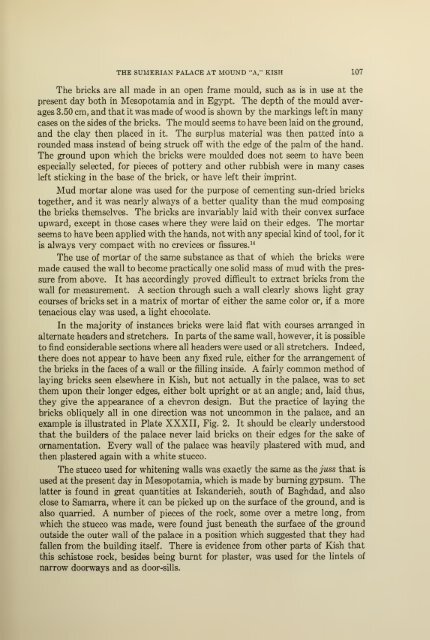A Sumerian Palace and the "A" cemetery at Kish, Mesopotamia
A Sumerian Palace and the "A" cemetery at Kish, Mesopotamia
A Sumerian Palace and the "A" cemetery at Kish, Mesopotamia
Create successful ePaper yourself
Turn your PDF publications into a flip-book with our unique Google optimized e-Paper software.
THE SUMERIAN PALACE AT MOUND "A," KISH 107<br />
The bricks are all made in an open frame mould, such as is in use <strong>at</strong> <strong>the</strong><br />
present day both in <strong>Mesopotamia</strong> <strong>and</strong> in Egypt. The depth of <strong>the</strong> mould averages<br />
3.50 cm, <strong>and</strong> th<strong>at</strong> it was made of wood is shown by <strong>the</strong> markings left in many<br />
cases on <strong>the</strong> sides of <strong>the</strong> bricks. The mould seems to have been laid on <strong>the</strong> ground,<br />
<strong>and</strong> <strong>the</strong> clay <strong>the</strong>n placed in it. The surplus m<strong>at</strong>erial was <strong>the</strong>n p<strong>at</strong>ted into a<br />
rounded mass instead of being struck off with <strong>the</strong> edge of <strong>the</strong> palm of <strong>the</strong> h<strong>and</strong>.<br />
The ground upon which <strong>the</strong> bricks were moulded does not seem to have been<br />
especially selected, for pieces of pottery <strong>and</strong> o<strong>the</strong>r rubbish were in many cases<br />
left sticking in <strong>the</strong> base of <strong>the</strong> brick, or have left <strong>the</strong>ir imprint.<br />
Mud mortar alone was used for <strong>the</strong> purpose of cementing sun-dried bricks<br />
toge<strong>the</strong>r, <strong>and</strong> it was nearly always of a better quality than <strong>the</strong> mud composing<br />
<strong>the</strong> bricks <strong>the</strong>mselves. The bricks are invariably laid with <strong>the</strong>ir convex surface<br />
upward, except in those cases where <strong>the</strong>y were laid on <strong>the</strong>ir edges. The mortar<br />
seems to have been applied with <strong>the</strong> h<strong>and</strong>s, not with any special kind of tool, for it<br />
is always very compact with no crevices or fissures."<br />
The use of mortar of <strong>the</strong> same substance as th<strong>at</strong> of which <strong>the</strong> bricks were<br />
made caused <strong>the</strong> wall to become practically one solid mass of mud with <strong>the</strong> pres-<br />
sure from above. It has accordingly proved difficult to extract bricks from <strong>the</strong><br />
wall for measurement. A section through such a wall clearly shows light gray<br />
courses of bricks set in a m<strong>at</strong>rix of mortar of ei<strong>the</strong>r <strong>the</strong> same color or, if a more<br />
tenacious clay was used, a light chocol<strong>at</strong>e.<br />
In <strong>the</strong> majority of instances bricks were laid fl<strong>at</strong> with courses arranged in<br />
altern<strong>at</strong>e headers <strong>and</strong> stretchers. In parts of <strong>the</strong> same wall, however, it is possible<br />
to find considerable sections where all headers were used or all stretchers. Indeed,<br />
<strong>the</strong>re does not appear to have been any fixed rule, ei<strong>the</strong>r for <strong>the</strong> arrangement of<br />
<strong>the</strong> bricks in <strong>the</strong> faces of a wall or <strong>the</strong> filling inside. A fairly common method of<br />
laying bricks seen elsewhere in <strong>Kish</strong>, but not actually in <strong>the</strong> palace, was to set<br />
<strong>the</strong>m upon <strong>the</strong>ir longer edges, ei<strong>the</strong>r bolt upright or <strong>at</strong> an angle; <strong>and</strong>, laid thus,<br />
<strong>the</strong>y give <strong>the</strong> appearance of a chevron design. But <strong>the</strong> practice of laying <strong>the</strong><br />
bricks obliquely all in one direction was not uncommon in <strong>the</strong> palace, <strong>and</strong> an<br />
example is illustr<strong>at</strong>ed in Pl<strong>at</strong>e XXXII, Fig. 2. It should be clearly understood<br />
th<strong>at</strong> <strong>the</strong> builders of <strong>the</strong> palace never laid bricks on <strong>the</strong>ir edges for <strong>the</strong> sake of<br />
ornament<strong>at</strong>ion. Every wall of <strong>the</strong> palace was heavily plastered with mud, <strong>and</strong><br />
<strong>the</strong>n plastered again with a white stucco.<br />
The stucco used for whitening walls was exactly <strong>the</strong> same as <strong>the</strong> juss th<strong>at</strong> is<br />
used <strong>at</strong> <strong>the</strong> present day in <strong>Mesopotamia</strong>, which is made by burning gypsum. The<br />
l<strong>at</strong>ter is found in gre<strong>at</strong> quantities <strong>at</strong> Isk<strong>and</strong>erieh, south of Baghdad, <strong>and</strong> also<br />
close to Samarra, where it can be picked up on <strong>the</strong> surface of <strong>the</strong> ground, <strong>and</strong> is<br />
also quarried. A number of pieces of <strong>the</strong> rock, some over a metre long, from<br />
which <strong>the</strong> stucco was made, were found just bene<strong>at</strong>h <strong>the</strong> surface of <strong>the</strong> ground<br />
outside <strong>the</strong> outer wall of <strong>the</strong> palace in a position which suggested th<strong>at</strong> <strong>the</strong>y had<br />
fallen from <strong>the</strong> building itself. There is evidence from o<strong>the</strong>r parts of <strong>Kish</strong> th<strong>at</strong><br />
this schistose rock, besides being burnt for plaster, was used for <strong>the</strong> lintels of<br />
narrow doorways <strong>and</strong> as door-sills.

















